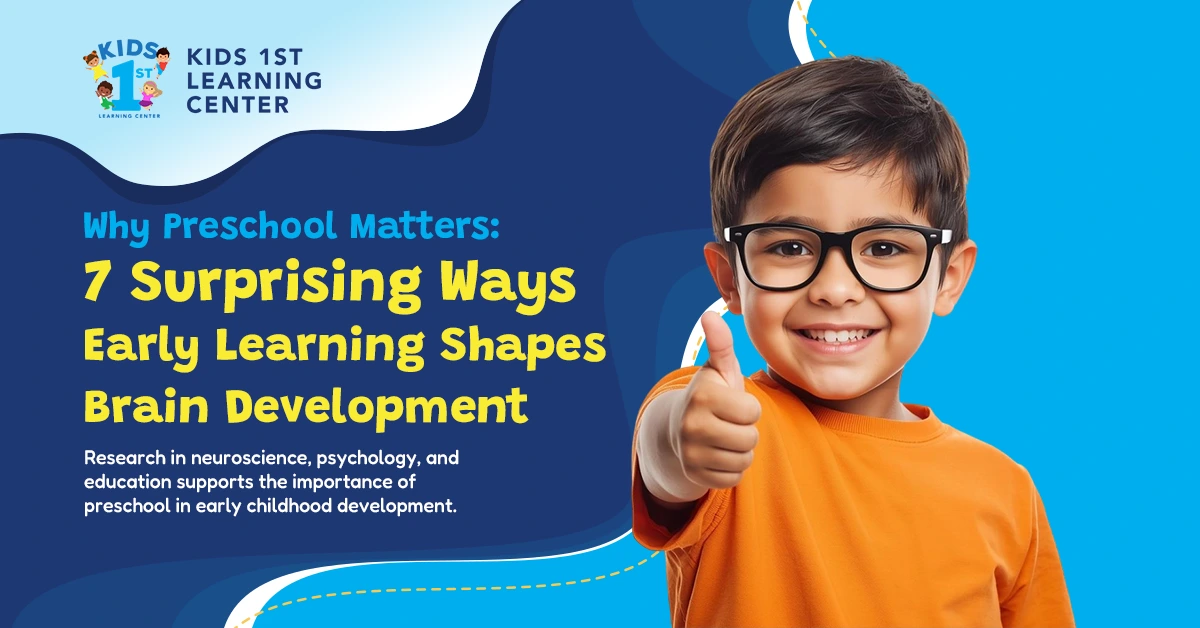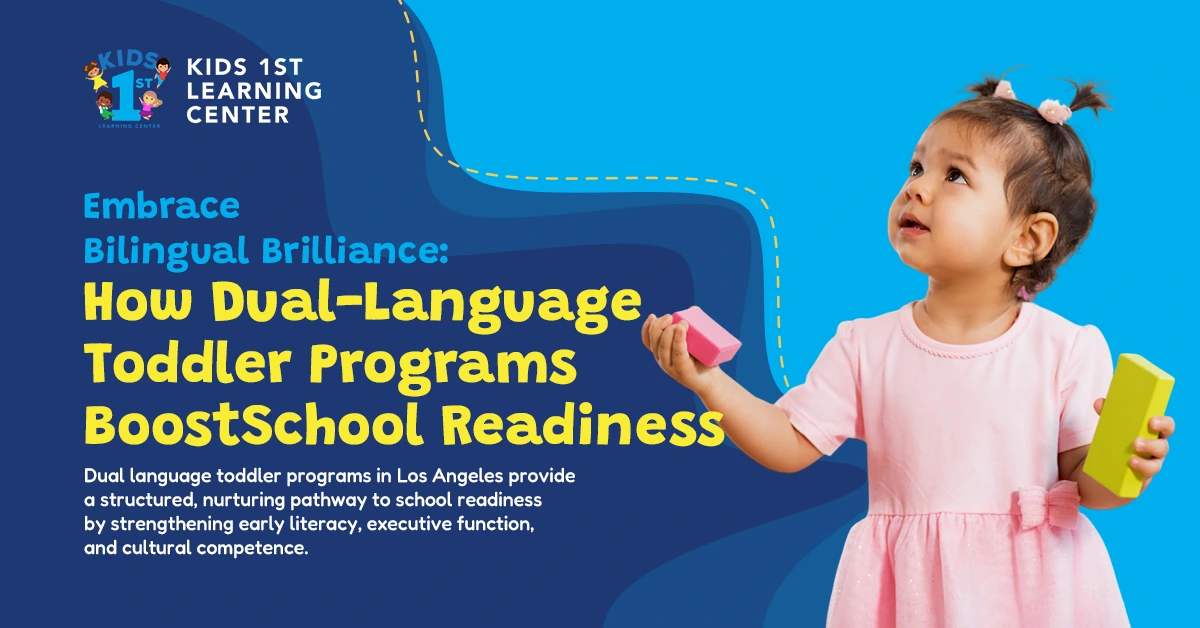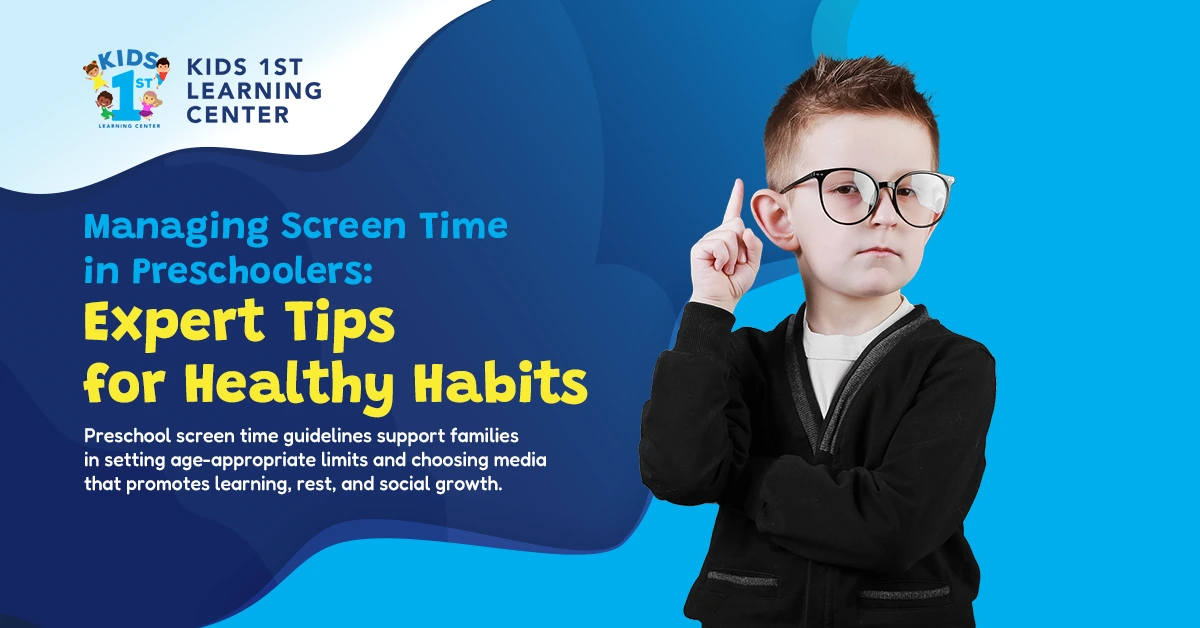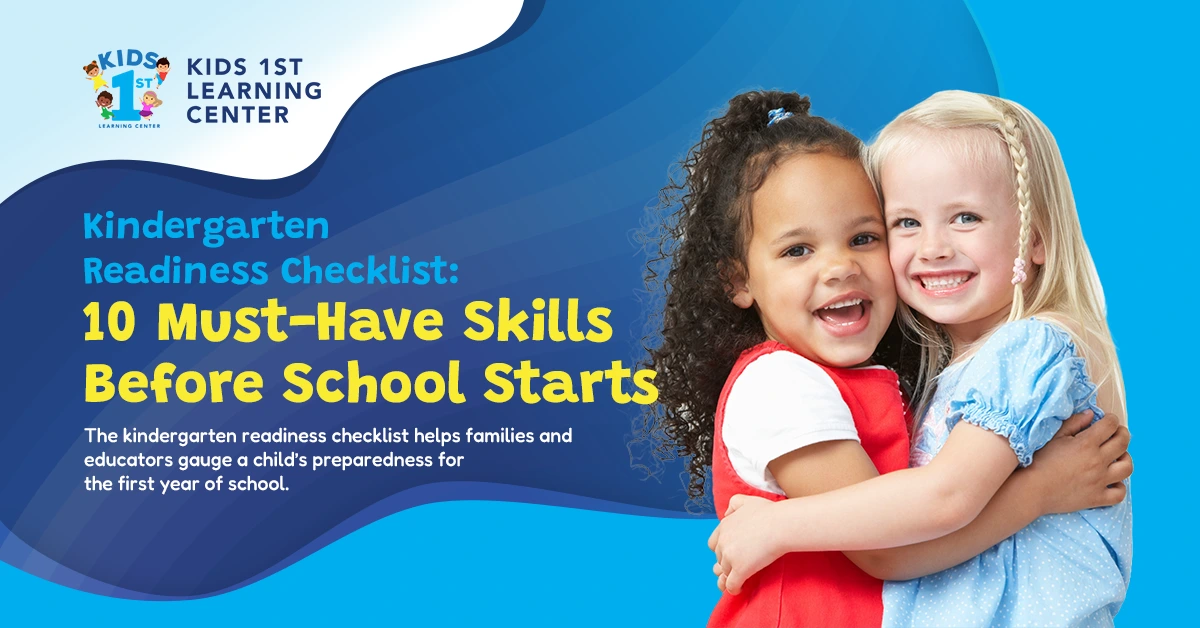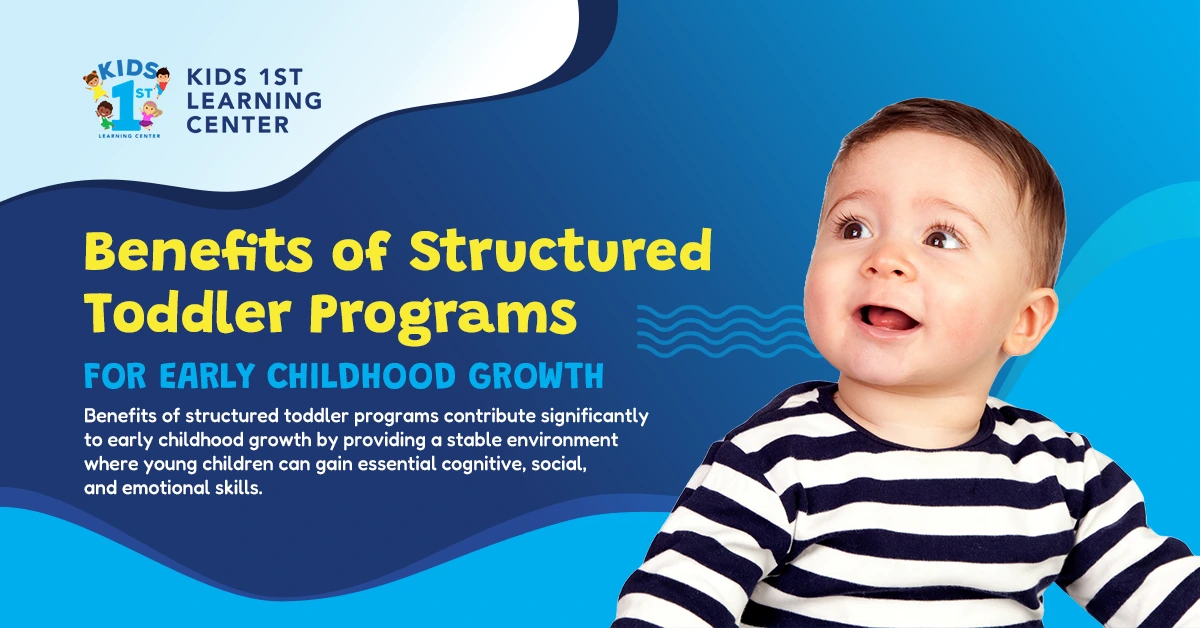Research in neuroscience, psychology, and education supports the importance of preschool in early childhood development. High-quality early learning environments strengthen the brain’s architecture through rich language exposure, purposeful play, and responsive relationships. Children practice self-regulation, build working memory, and learn to follow multi-step directions that support later reading and math.
Daily routines create a predictable structure, while open-ended exploration nurtures curiosity and problem-solving. Guided social interaction teaches empathy, cooperation, and conflict resolution. Together, these experiences lay the foundations for attention, persistence, and academic readiness, helping children transition smoothly into kindergarten and continue growing with confidence.
1. Cognitive Benefits of Preschool: Memory, Attention, and Problem Solving
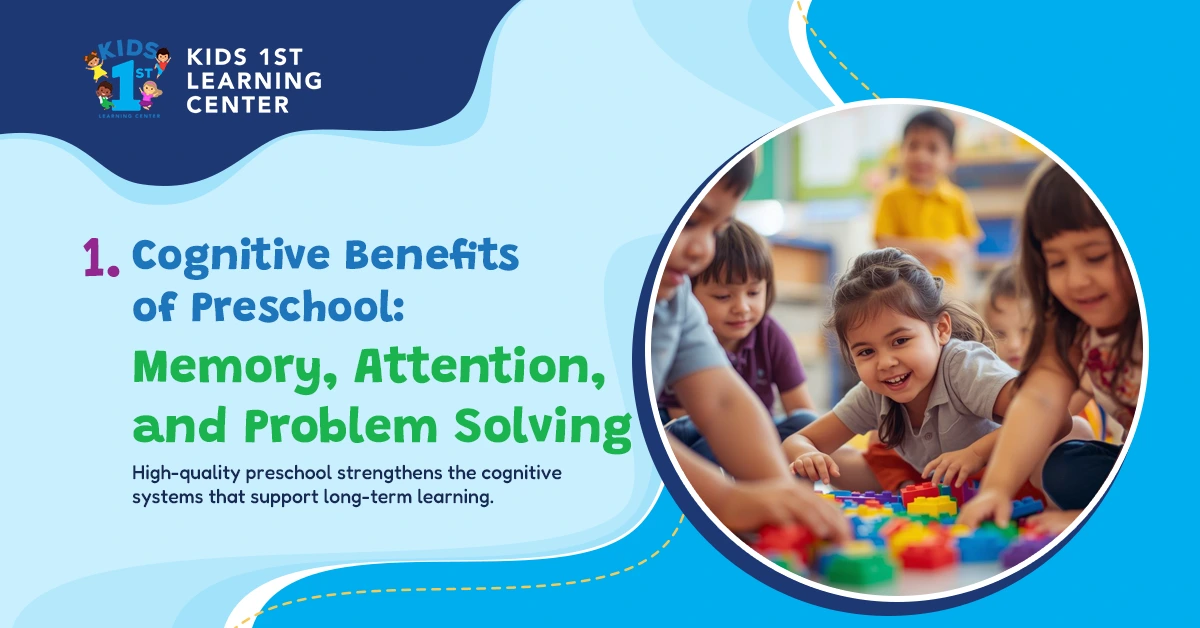
High-quality preschool strengthens the cognitive systems that support long-term learning. Daily routines, small group lessons, and guided play help children practice working memory, sustain attention during multi-step tasks, and approach challenges with flexible thinking. These skills form the primary grades’ base for reading, math, and scientific reasoning.
Working Memory
Children learn to hold information in mind and use it. Teachers model short directions, add visual cues, and gradually increase complexity. Sequence songs, treasure maps with two or three steps, and story recall build the capacity to remember and act.
Sustained Attention
Engaging tasks with clear starts and finishes help children focus. Rotating materials, limiting distractions, and setting short-term goals encourage persistence. Visual schedules and simple checklists guide children to monitor their attention and return to the task after brief interruptions.
Problem Solving and Flexible Thinking
Open-ended materials invite experimentation and revision. Block structures require balance and planning. Simple science investigations ask children to predict, test, and explain results. Teachers prompt reasoning with questions such as what changed and what you could try next.
Classroom Features That Support Cognition
- Consistent routines and visual supports
Materials organized by purpose and difficulty
Small groups with targeted goals
Brief reflection that names strategies and progress
Purposeful practice in preschool builds memory, attention, and problem-solving that children carry into kindergarten.
2. Early Brain Development Activities That Build Neural Connections
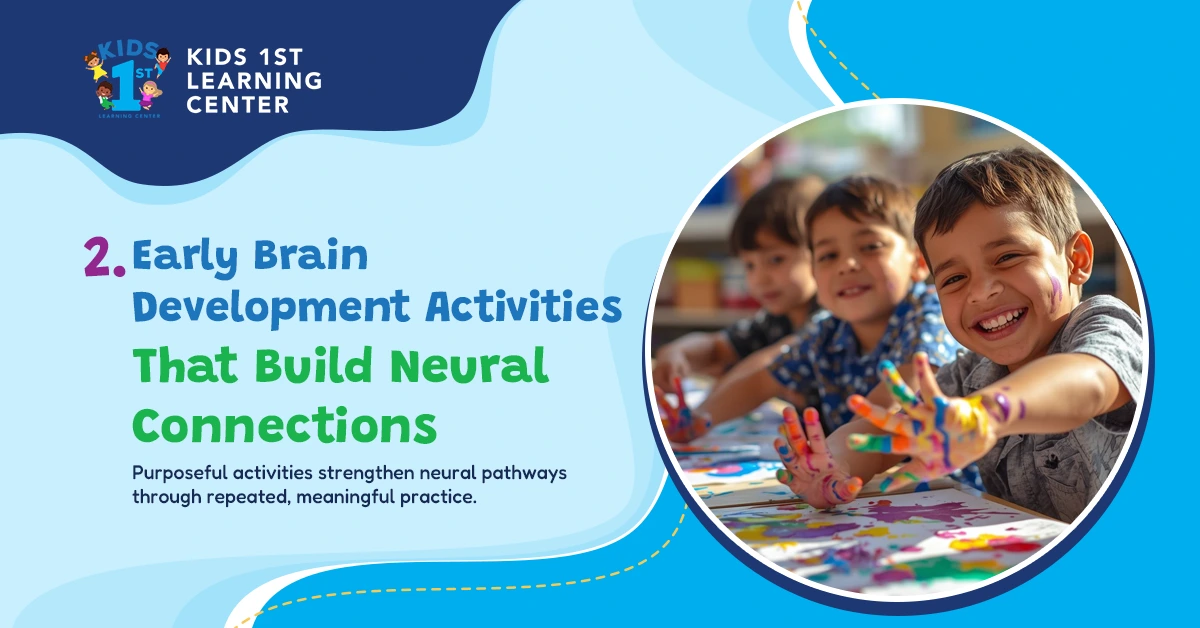
Purposeful activities strengthen neural pathways through repeated, meaningful practice. In preschool, teachers pair movement, language, and sensory input so children engage multiple systems at once. This integration supports attention, memory, and early problem-solving throughout the day.
Sensory Exploration
Water, sand, and natural materials encourage pouring, sifting, and comparing textures. Children describe qualities such as rough, smooth, heavy, and light, which builds vocabulary and fine motor control. Simple tools like scoops and funnels extend experimentation.
Movement and Coordination
Obstacle paths, dance routines, and outdoor play build balance and body awareness. Crossing the midline during throws or claps helps integrate hemispheres. Short movement breaks between seated tasks improve alertness and readiness to learn.
Language and Music
Songs, chants, and fingerplays pair rhythm with sequence. Repetition supports auditory memory and phonological awareness. Shared reading with picture prompts invites prediction, retell, and rich conversation.
Fine Motor Readiness
Playdough shaping, tweezers, and lacing cards strengthen small muscles for drawing and writing. Vertical surfaces, such as easels, promote wrist stability and proper pencil grasp.
Early Math and Science
Sorting, patterning, and measuring activities develop number sense and classification. Simple experiments with ramps, magnets, or seeds encourage observation and cause-and-effect reasoning.
Family Extensions
- Offer daily outdoor movement and exploration
Read aloud and talk about new words
Provide tools for drawing and building
Cook together and compare amounts
Play turn-taking games and discuss strategies
Consistent, well-designed activities create repeated practice that builds durable neural connections and supports future learning.
3. How Preschool Impacts Learning Skills for Kindergarten Readiness
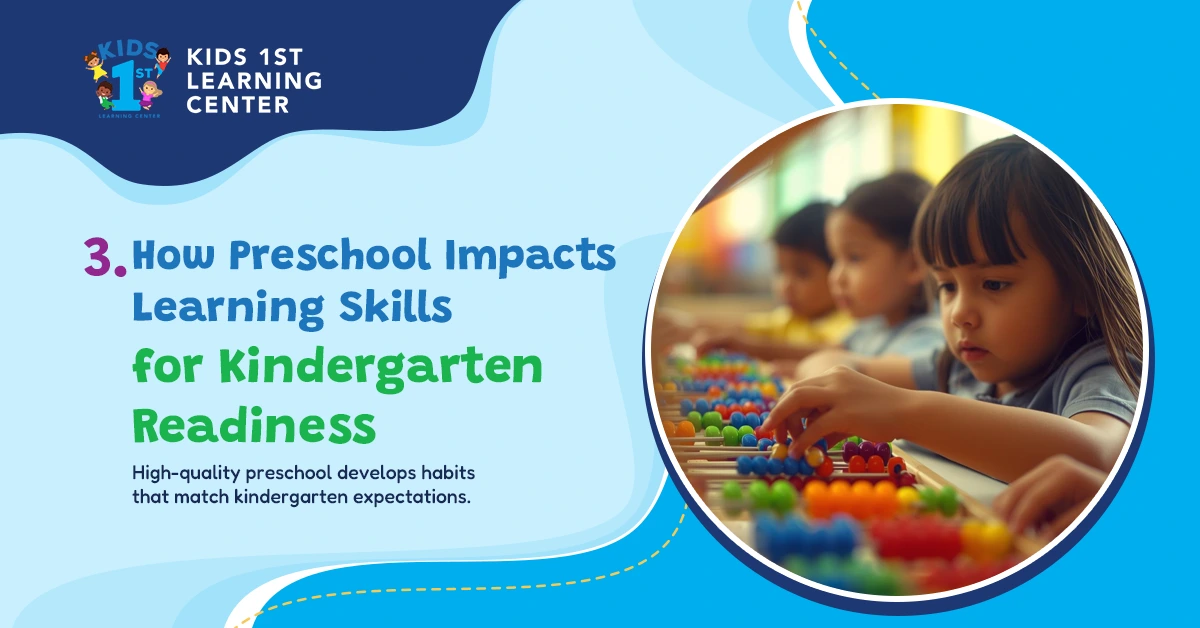
High-quality preschool develops habits that match kindergarten expectations. Daily routines, purposeful play, and small group instruction build early academics, self-regulation, and communication so children enter school ready to participate and learn.
Early Literacy
Shared reading, songs, and name writing build print awareness, phonological skills, and vocabulary. During short, focused lessons, children practice retelling stories, recognizing letters, and connecting sounds to symbols.
Early Math
Hands-on materials support counting, comparing, and patterning. Children sort objects, measure with simple tools, and describe shapes, strengthening number sense and preparing them for formal instruction.
Executive Function
Visual schedules and clear routines teach children to follow multi-step directions and shift between activities. Brief planning talks and reflection help children set goals, persist, and monitor progress.
Social Communication
Circle time and centers provide practice with listening, speaking in turns, and respectfully resolving conflicts. Teachers model clear language for asking questions, seeking help, and explaining ideas.
Fine Motor Readiness
Playdough, tweezers, crayons, and scissors build strength and control for drawing and writing. Vertical surfaces support wrist stability and a mature grasp.
Family Partnership
Regular updates and simple home activities extend learning. Families read aloud, play counting games, and encourage step-by-step tasks.
Kindergarten Readiness Snapshot
- Recognizes letters and counts objects with one-to-one correspondence
Follows routines and multi-step directions
Uses scissors and crayons with control
Works cooperatively and seeks help appropriately
Balanced development across these areas supports a confident transition to kindergarten and sustained growth in the primary grades.
Social and Emotional Growth, Self-Regulation, and Executive Function
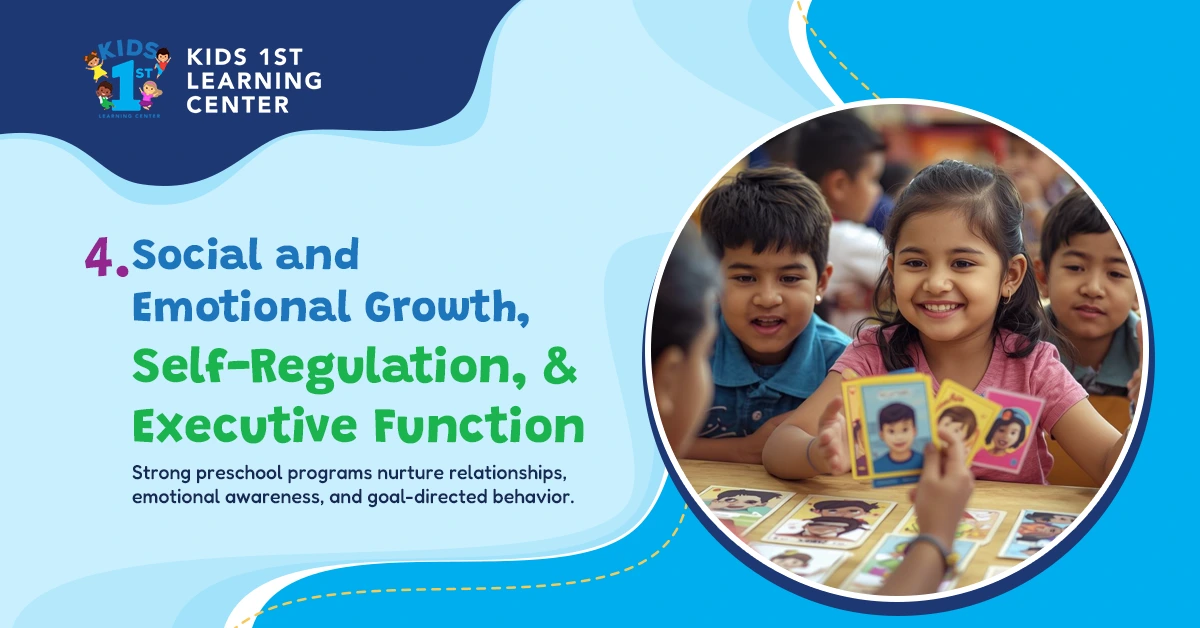
Strong preschool programs nurture relationships, emotional awareness, and goal-directed behavior. Children learn to name feelings, consider others, and practice choices that keep groups safe and productive. These experiences build the foundation for attention, planning, and flexible thinking.
Emotional Literacy
Teachers model feeling words and calm strategies during real moments. Children practice identifying emotions in stories, pictures, and peer interactions. Simple tools such as a feelings chart and a quiet space help children notice cues and return to learning.
Self-Regulation Skills
Predictable routines, visual schedules, and clear signals guide children through transitions. Short tasks with defined starts and finishes encourage stamina. Breathing prompts, counting, and movement breaks support recovery when frustration rises.
Executive Function in Daily Play
Children plan roles in dramatic play, gather materials, and follow agreed-upon steps. Small group games require remembering rules, taking turns, and adjusting strategies. Teachers prompt reflection with questions about goals, what changed, and next steps.
Positive Social Problem Solving
Coaching helps children use respectful words, listen to a partner, and suggest fair solutions. Peer mediation cards or scripts provide structure while children build confidence.
Classroom Practices That Support Growth
- Consistent routines and clear expectations
Warm relationships and responsive feedback
Calm corners and sensory tools
Games that build memory and flexible thinking
Balanced attention to social and emotional growth strengthens self-regulation and executive function, which supports learning throughout the preschool day.
5. Language, Literacy, and Numeracy Foundations Through Play
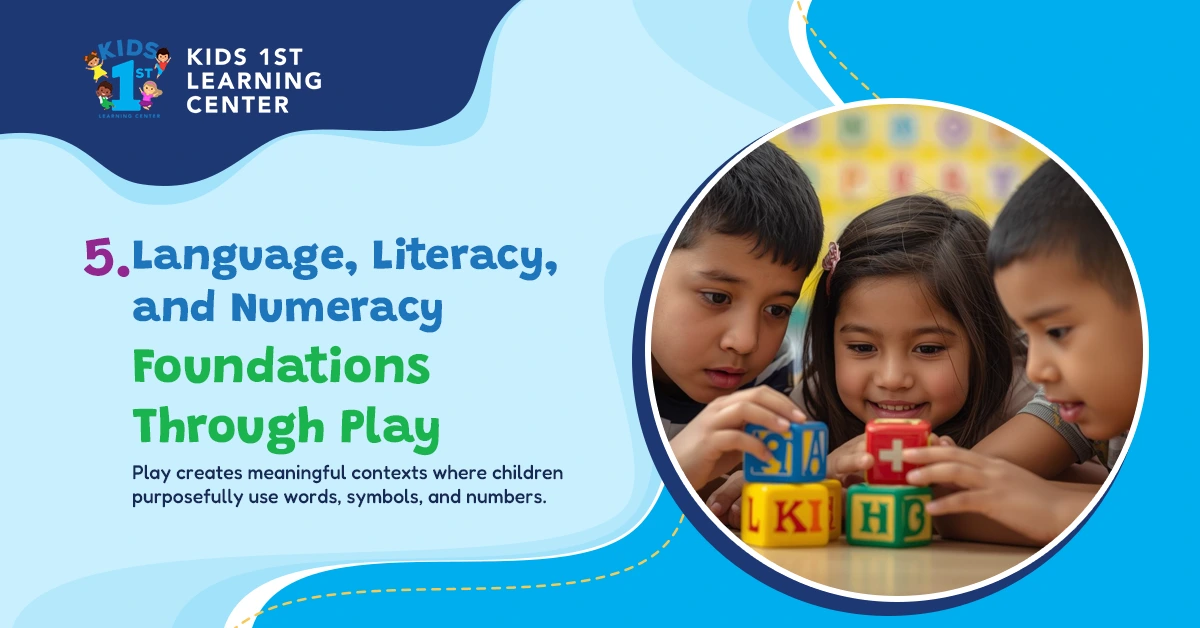
Play creates meaningful contexts where children purposefully use words, symbols, and numbers. Teachers design centers that invite conversation, problem-solving, and hands-on exploration. These experiences connect talk, print, and quantity in natural and engaging ways.
Play-Based Language Growth
Dramatic play encourages planning, role vocabulary, and clear sentences. Teachers model precise words, expand children’s ideas, and ask open questions. Songs and fingerplays strengthen auditory memory and sound awareness that support later reading.
Early Literacy in Action
Print becomes useful when it helps children meet goals. Sign-in boards, labels for science drawings, and caption dictation make reading and writing relevant. Shared reading builds concepts of print, rhyme, and sequence. Short, small groups practice letter sounds and meaningful word use.
Numeracy Through Hands-On Exploration
Children count, compare, and measure while building and sorting. Blocks support shape names and spatial language. Beads and tiles create patterns. Cooking and water tables introduce measuring, estimating, and simple recording.
Integrated Learning Centers
A grocery store center might include picture lists, number cards, and simple receipts. Children plan purchases, count items, and write quick notes. Teachers guide reflection about what worked and what changed.
Family Extensions
- Read aloud daily and discuss new words
Play board games that involve counting and turn-taking
Cook together and compare amounts
Make simple lists for errands and invite children to check items
Purposeful play links language, literacy, and math through real tasks and conversations. Consistent practice at school and home helps children develop strong foundations for future learning.
6. Family Partnerships and Home Extensions That Sustain Progress
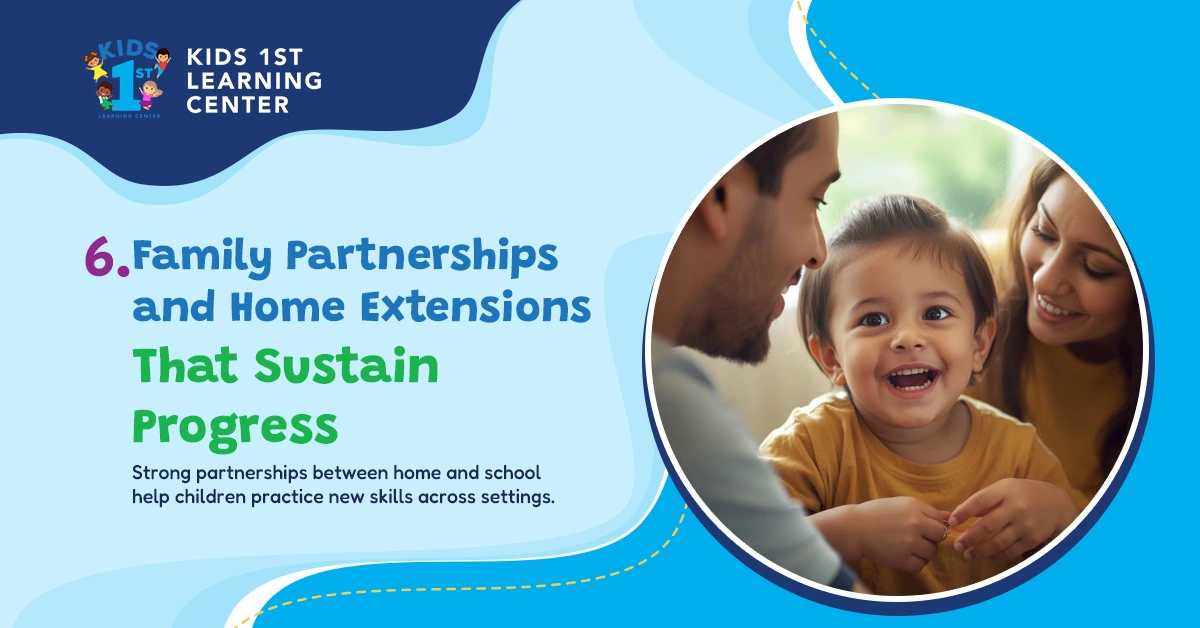
Strong partnerships between home and school help children practice new skills across settings. Clear communication, shared routines, and simple activities at home reinforce learning from the classroom and support steady growth.
Home–School Communication
Teachers provide updates through brief notes, secure apps, or weekly summaries. Families share questions, cultural preferences, and routines that comfort their child. Consistent two-way communication helps align expectations and strategies.
Simple Routines at Home
Predictable schedules for meals, play, and bedtime support self-regulation. Visual checklists guide children through getting dressed, packing a bag, and cleaning up. Short tasks with clear finishes build confidence and independence.
Learning Extensions
Read aloud daily and discuss new words. Count household items, sort laundry by color or size, and make simple patterns with toys. Cooking together introduces measuring, sequencing, and turn-taking.
Culturally Responsive Partnership
Invite home languages, stories, and traditions into classroom activities. Families can share songs, artifacts, or recipes that connect learning to identity and community. Children feel seen and bring a rich vocabulary to school discussions.
Progress Sharing and Goal Setting
Teachers document growth with photos, work samples, and observation notes. Families review progress and set specific goals, such as naming shapes, zipping a jacket, or using words to solve conflicts.
Quick Family Checklist
- Read, sing, and talk every day
Use visual routines for everyday tasks
Play simple games that involve counting and memory
Share cultural traditions and home languages
Celebrate small gains and name the strategies that helped
When families and teachers work together, children experience consistent support that sustains progress throughout the preschool year.
7. Assessment, Transition, and Kindergarten Readiness Planning
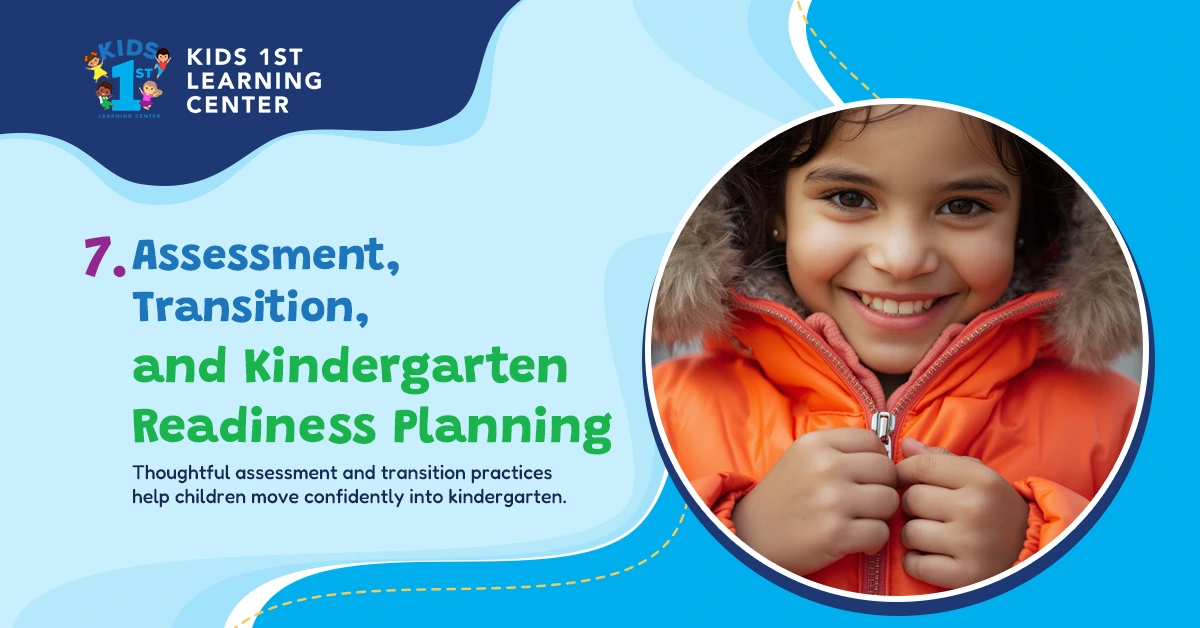
Thoughtful assessment and transition practices help children move confidently into kindergarten. Teachers gather information over time, share clear updates with families, and plan supports matching each child’s strengths and needs.
Ongoing Assessment
Observation notes, photos, and work samples depict growth across language, math, motor, and social skills. Short checklists or screenings identify areas that need practice. Teachers use this information to tailor small groups, adjust materials, and set short, achievable goals.
Family Communication and Conferences
Regular updates explain what a child is learning and how progress is measured. Conferences invite families to share home routines, cultural preferences, and goals. Together, teachers and families choose simple strategies that can be practiced at school and home.
Transition Activities
Children tour kindergarten classrooms, meet new staff, and try short routines such as lining up, storing backpacks, and joining a morning meeting. Portfolio folders with photos and sample work help receiving teachers understand interests, strengths, and support needs.
Kindergarten Readiness Planning
A balanced plan includes academic, social, and self-care skills. Practice zippering coats, opening containers, and following multi-step directions. Read daily, count real objects, and play games that build memory and turn-taking.
Readiness Checklist
- Follows classroom routines and simple rules
Uses words to ask for help and solve conflicts
Recognizes letters, counts objects, and names shapes
Uses scissors and crayons with control
Shows persistence and pride in effort
Clear assessment, open communication, and gradual transition create a strong pathway from preschool to kindergarten.
Conclusion
High-quality preschool creates a strong foundation for thinking, language, and social growth. Purposeful play, responsive teaching, and consistent routines strengthen memory, attention, and problem-solving. Children build early literacy and numeracy through meaningful activities that connect words, ideas, and quantities. Daily practice with self-regulation and collaboration prepares children to participate, persist, and communicate effectively. Children carry new skills into kindergarten and beyond when school and home work together.
If planning next steps, connect with a team that values safety, communication, and developmentally appropriate learning. Contact Kids 1st at (818) 873-0133 or visit https://kids1st.org/contact-kids-1st/.

